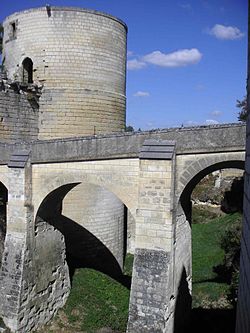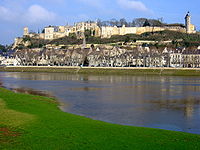- Château de Chinon
-
Chinon is a castle located on the bank of the Vienne river in Chinon, France.
History
The importance of Chinon derives from its position on the bank of the Vienne river in Chinon, France just before it joins the Loire. From prehistoric times, the rivers of France formed the major trade routes, and the Vienne joins the fertile southern plains of the Poitou and the city of Limoges to the thoroughfare of the Loire, thus giving access to the sea at the port of Nantes on the western coast, and to the Île-de-France in the east. Chinon offers an easy crossing point by means of a central island in the Vienne, and the rocks dominating the shore provided not only a natural fort, but also protection against the annual flooding of the river
The site appears to have been used for a Gallo-Roman castrum; recent excavations during the restoration of the chateau have uncovered arms and ornaments dating from the 1st century AD. Towards the end of the 4th century, a follower of St Martin, St Mexme, established first a hermitage, and then a monastery on the eastern slope of the town. This foundation flourished throughout Middle Ages, being rebuilt and extended four times; the eventual complex contained a large and highly decorated church, a cloister and a square of canons' residences. Unfortunately the all too familiar pattern of Huguenot damage in the sixteenth century, followed by closure and partial demolition during the Revolution of 1789 and onwards has left only a much-damaged facade,and part of the nave, although the building has now been restored as a cultural centre.
The mount of Chinon was first fortified as a stronghold by Theobald I, Count of Blois in the year 954. In the 12th century Chinon, located in (then) County of Anjou, which was then independent of the kingdom of France, was a primary residence of Henry II (Angevin King and King of England) and served with Poitiers and Bordeaux as a key southern capital of the vast Angevin holdings. Henry was responsible for construction of almost all of the massive chateau, encompassing a site over 500 metres long and 75m wide, with a clock tower (14th century) rising 115 feet (35 m) high. King Henry died in Chinon castle after being defeated by his sons Richard and John in a rebellion aided by Phillip Augustus of France; he, his wife Eleanor of Aquitaine, and their son King Richard the Lionheart were all buried at nearby Fontevraud Abbey.
In 1308, three senior officers of the Knights Templar, including the Grand Master,Jacques du Molay, were incarcerated before their condemnation and execution in Paris.
The chateau was a residence of Charles VII, the Dauphin of France in the early 15th century, when Touraine was virtually the only territory left to him in France, the rest being occupied by the Burgundians or the English. Joan of Arc arrived at the castle, at the beginning of her quest to liberate France from the English on March 8, 1429; it was here that she recognized the disguised Dauphin from amongst his courtiers, a feat which helped to persuade him to accede to her urging to declare himself king and raise an army to liberate France.
In 1562 the chateau came briefly into the possession of the Huguenots and was turned into a state prison by Henry IV of France. After that it was abandoned until 1793 when, during the Reign of Terror, the castle was temporarily occupied by Vendeans. Soon though, it was left to decay until Emperor Napoleon III began a partial effort at restoration, supervised by Prosper Mérimée(the author of the story 'Carmen'). Today, it is managed by the Town of Chinon and is a major tourist attraction.
Since 1840, the castle has been recognised as a monument historique by the French Ministry of Culture.
Description
The castle is divided, along its length, into three enclosures, each separated by a deep dry moat. The easternmost is known as Fort St.-Georges, the central called the Château de Milieu, while the westernmost is known as the Fort du Coudray. In the early 13th century, following the Capetian annexation of Anjou in 1205, a cylindrical keep similar to those at Rouen and the Louvre, was added by Philip Augustus, King of France, to the entrance of the Fort du Coudray.
In the keep or donjon, called the Tour de Coudray, Templar three knights were imprisoned during the brutal suppression of the Templar Order that occurred in 1308. Some of the prisoners carved odd symbols into the walls of their cells: Hearts, Stars of David, grids, and other geometrical patterns. It is unknown if they were random symbols, or represented a code of some type.[1]
Between 2003 & 2009, the castle was the subject of a massive excavation and restoration project, costing 17 million euros. The royal lodgings (Logis Royales) which have been roofless for two hundred years, have been restored inside and out, and now boast wooden or tiled floors and ceilings, as well as state-of-the-art underfloor heating. The ramparts have been rebuilt, and the Fort St. Georges, which existed only as groundwork, has been rebuilt as a visitor centre and entrance hall. The aim of the restorations is to present a realistic vision of a medieval fortress in a liveable and usable state, with an extended and upgraded museum of finds from the excavations and local memorabilia.
Access has been revolutionised by the construction of a glass-sided lift, which connects the car park just behind the central square with the clock-tower (Tour de Horloge)of the chateau.
References
- ^ The History Channel, Decoding the Past: The Templar Code, video documentary, November 7, 2005, written by Marcy Marzuni
Categories:- Châteaux of the Loire Valley
- Buildings and structures in Indre-et-Loire
Wikimedia Foundation. 2010.


